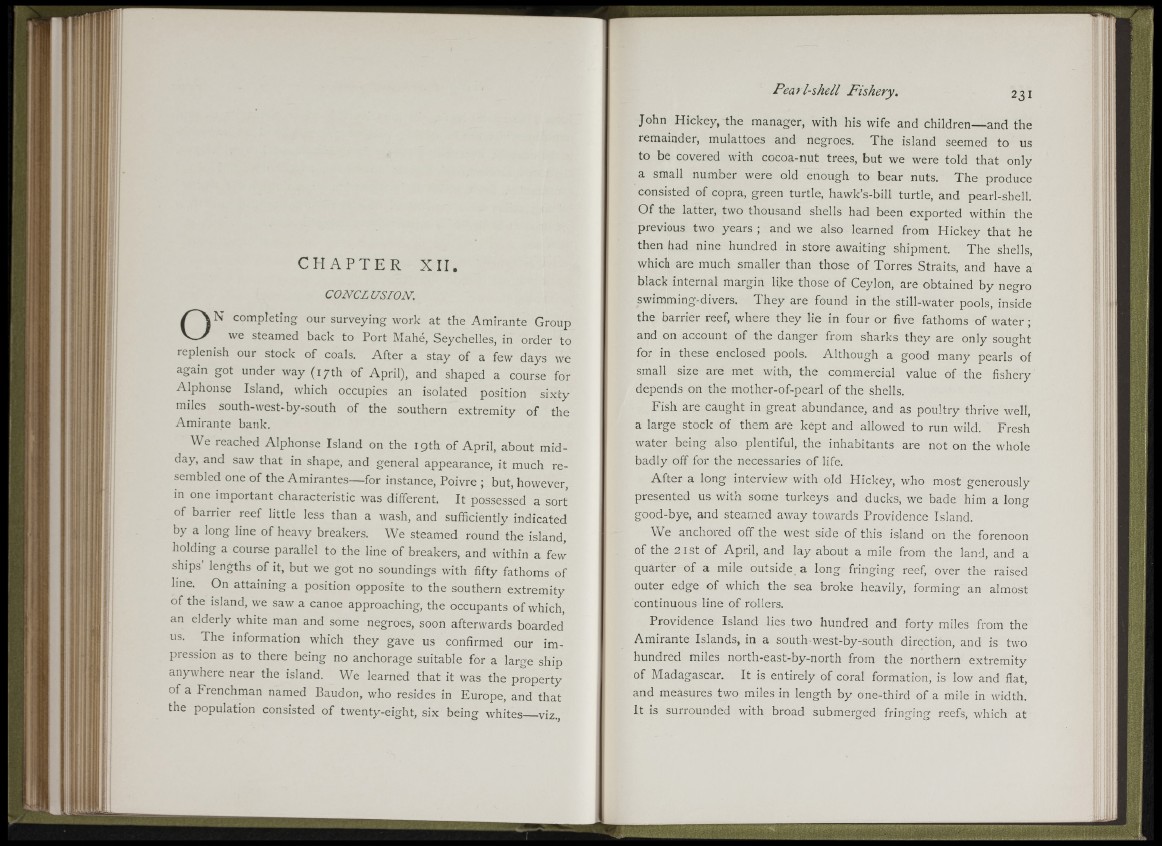
Pearl-shell Fishery. 231
C H A P T E R X I I .
CONCL USION.
ON completing our surveying work at the Amirante Group
we steamed back to Port Mahe, Seychelles, in order to
replenish our stock of coals. After a stay of a few days we
again got under way (17th of April), and shaped a course for
Alphonse Island, which occupies an isolated position sixty
miles south-west-by-south of the southern extremity of the
Amirante bank.
We reached Alphonse Island on the 19th of April, about midday,
and saw that in shape, and general appearance, it much resembled
one of the Amirantes— for instance, Poivre ; but, however,
in one important characteristic was different. It possessed a sort
of barrier reef httle less than a wash, and sufficiently indicated
by a long line of heavy breakers. We steamed round the island,
holding a course parallel to the line of breakers, and within a fevv
ships lengths of it, but we got no soundings with fifty fathoms of
line. On attaining a position opposite to the southern extremity
of the island, we saw a canoe approaching, the occupants of which,
an elderly white man and some negroes, soon afterwards boarded
us. The information which they gave us confirmed our impression
as to there being no anchorage suitable for a large ship
anywhere near the island. We learned that it was the property
of a Frenchman named Baudon, who resides in Europe, and that
the population consisted of twenty-eight, six being whites viz..
John Hickey, the manager, with his wife and children— and the
remainder, mulattoes and negroes. The island seemed to us
to be covered with cocoa-nut trees, but we were told that only
a small number were old enough to bear nuts. The produce
consisted of copra, green turtle, hawk’s-bill turtle, and pearl-shell.
Of the latter, two thousand shells had been exported within the
previous two years ; and we also learned from Hickey that he
then had nine hundred in store awaiting shipment. The shells,
whicli are much smaller than those of Torres Straits, and have a
black internal margin like those of Ceylon, are obtained by negro
swimming-divers. They are found in the still-water pools, inside
the barrier reef, where they lie in four or five fathoms of water ;
and on account of the danj^ci from sharks they are only sought
for in these enclosed pools. Although a good many pearls of
small size are met with, the commercial value of the fishery
depends on the mother-of-pearl of the shells.
Fish are caught in great abundance, and as poultry thrive well,
a large stock of them are kept and allowed to run wild. Fresh
water being also plentiful, the inhabitants are not on the whole
badly off for the necessaries of life.
After a long interview with old Hickey, who most generously
presented us with some turkeys and ducks, Ave bade him a long
good-bye, and steamed a A v a y towards Providence Island.
We anchored off the west side of this island on the forenoon
of the 2is t of April, and lay about a mile from the land, and a
quarter of a mile outside a long fringing reef, over the raised
outer edge of which the sea broke heavily, forming an almost
continuous line of rollers.
Providence Island lies two hundred and forty miles from the
Amirante Islands, in a south west-by-south direction, and is two
hundred miles north-east-by-north from the northern extremity
of Madagascar. It is entirely of coral formation, is low and flat,
and measures two miles in length by one-third of a mile in width.
It is surrounded with broad submerged fringing reefs, which at
ilP
' ilili
!■ I’¡I'
'-■U
!U. ill ii